How to Sauté: A Step-by-Step Guide
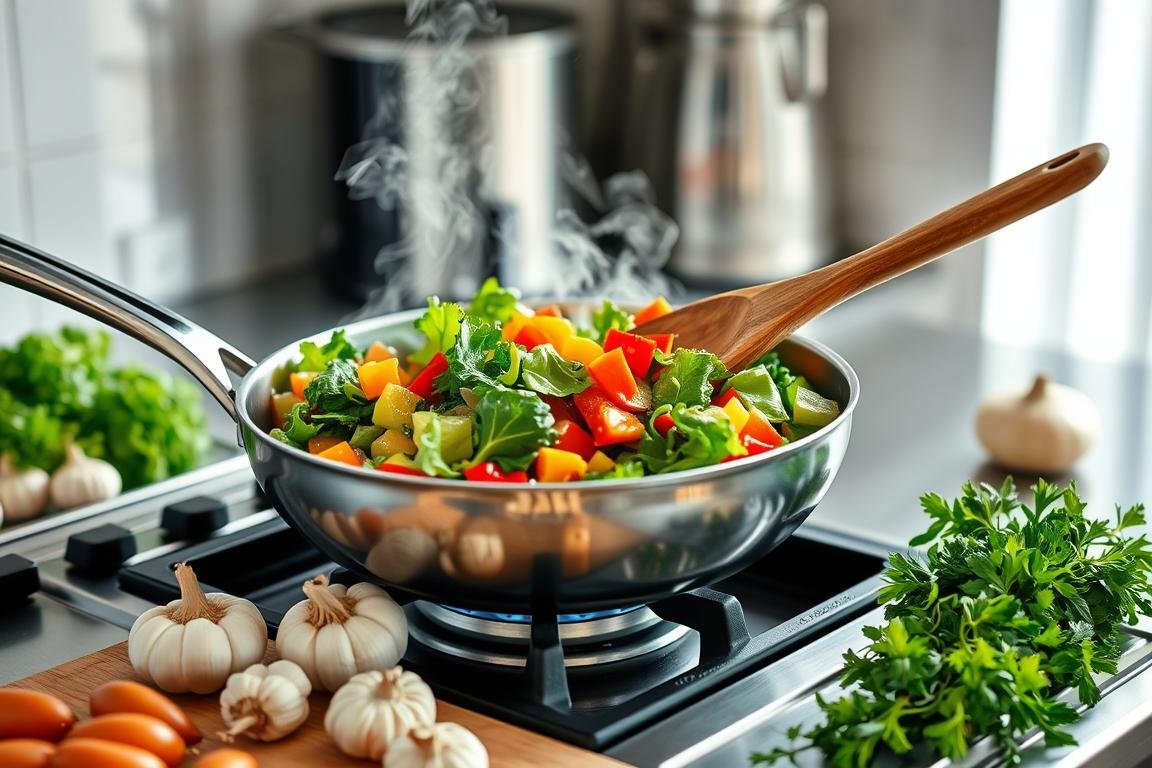
Ever been amazed by the great smell and look of sautéed food? But, when you try it at home, it just doesn’t turn out right? Don’t worry. Sautéing is an art that turns simple ingredients into a feast of tastes. With this guide, you’ll learn to sauté like a pro. You’ll be able to cook up dishes that’ll make everyone stand up and clap, right in your own kitchen.
Sautéing is all about quick moves. High heat, just the right amount of oil, and the perfect timing are key. You’ll use a stainless steel pan, which is best for spreading heat evenly. This guide will show you how to manage heat and oil. That way, your food turns out just right – tender inside, great to bite into. We’ll show you how to use your skillet right. So, you can make meals that are good for you and taste amazing too.
Key Takeaways
- Discover the essentials of using the right type of pan and oil with high smoke points for successful sautéing techniques.
- Learn to achieve the coveted balance of fully cooked, moist, and firm ingredients through the nuances of a step-by-step guide.
- Understand the importance of not overcrowding your skillet to ensure even cooking and browning of your skillet recipes.
- Realize the versatility of sautéing and its ability to pair harmoniously with a myriad of other cooking methods.
- Master the timing and stirring necessary to preserve the vibrant textures and flavors of sautéed foods.
Understanding the Sautéing Technique
Learning about sautéing will improve your cooking skills. It’s a mix of art and science, using techniques like the Maillard reaction. This reaction helps turn simple foods into delicious meals with high heat and careful timing. Let’s dive into what makes sautéing special.
What Does Sautéing Mean?
Sautéing cooks food fast in a little oil or fat over high heat. It’s different from other methods because it doesn’t use water or broth. The food directly touches the hot pan. This creates a seared surface that tastes good, looks good, and keeps the inside moist and full of flavor. It’s key for both fancy and simple meals.
When to Use Sautéing
Use this method for mushrooms, onions, or tender meats. It’s perfect for when you want a caramelized outside and juicy middle. Sautéing is great for a quick stir-fry or starting a sofrito. It works well for many kinds of food, like veggies, meat, and things that add flavor.
Key Benefits of Sautéing
Sautéing is quick and keeps the food’s nutrients and flavors. Using a bit of oil, this dry-heat method cooks food fast. This way, food keeps its texture and color better than slow cooking.
Knowing different sautéing techniques will change the way you cook. Turning simple foods into great meals needs the right pan and knowing how to use it. Let’s learn how to get better at sautéing.
| Factor | Importance | Tip |
|---|---|---|
| Choice of Pan | Crucial | Use a heavy skillet or a sauté pan that conducts heat well and can withstand high-heat cooking. |
| Ingredient Prep | Essential | Cut ingredients uniformly to ensure even cooking. |
| Heating the Pan | Essential | Ensure the pan is adequately heated before adding oil and ingredients to prevent sticking and achieve a perfect sear. |
| Oils for Cooking | Important | Choose oils with a higher smoke point, such as grape seed or avocado oil, to maintain the quality under high heat. |
Mastery in sautéing brings out new flavors. The right pan and technique matter a lot. Try it out and see how it improves your dishes.
Essential Tools for Sautéing
To master sautéing, you need the right gear. We’ll show you the must-have cookware and utensils. We’ll also suggest some extra gadgets to make cooking faster and more fun. Whether you’re just starting or improving your skillet skills, these tools will help make sautéing easier and more enjoyable.
Must-Have Cookware
The sauté pan is at the heart of sautéing. The best pans are often made of stainless steel or cast iron. They are great at keeping heat and lasting a long time. A good pan has a flat, thick bottom to cook food evenly without burning.
Sauté pans are different from regular skillets because they have deeper sides. This lets you toss and flip food easily without making a mess.
Recommended Utensils
For sautéing veggies or meats, some utensils are very helpful. Kitchen tweezers and spatulas are great for flipping and stirring. This helps cook everything well. If you want tools that last, get spatulas made of heat-resistant silicone or wood. They don’t melt or scratch your pan.
Optional Gadgets for Efficiency
Some gadgets, while not necessary, can make sautéing better. Softening hard veggies in the microwave saves time.
High-tech stoves, like the Whirlpool® Gas Range with special grates and burners, spread heat well. They’re great for quick sautéing and getting a good sear.
| Cooking Technique | Tool or Utensil | Heat Setting | Cooking Time |
|---|---|---|---|
| Sautéing | Sauté pan, spatulas | Medium to High (350°F) | Varies per ingredient |
| Pan Frying | Skillet (12-14 inches) | Medium to High | Depends on food type |
| Caramelizing Onions | Stainless steel pan | Low (for extended time) | At least 45 minutes |
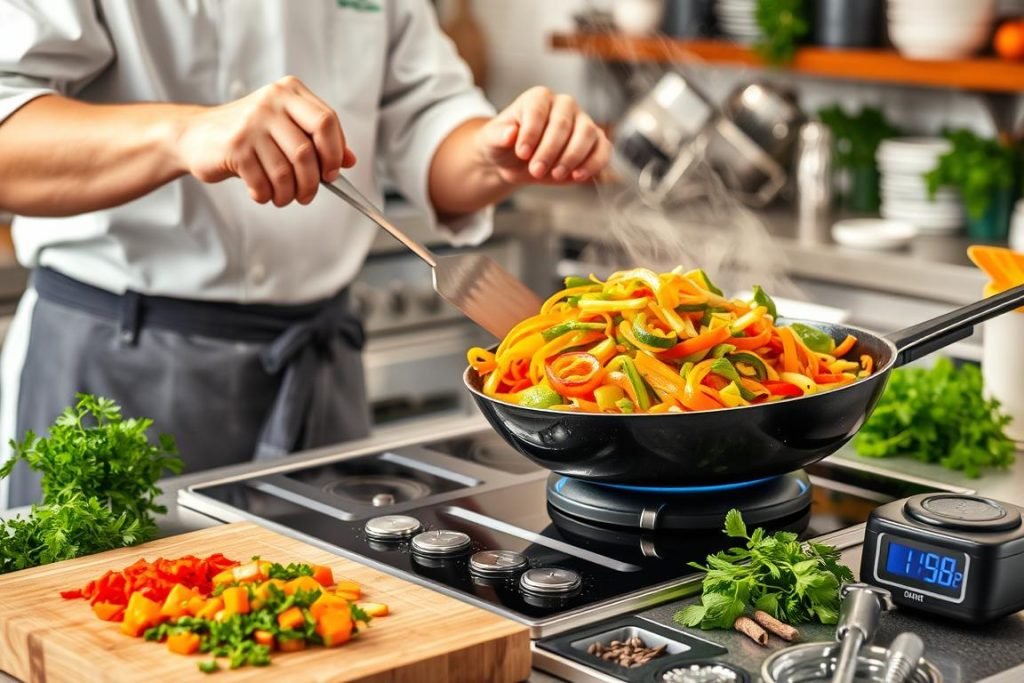
The key to good sautéing is steady heat and the right moves. Try different skillet recipes to get better and more confident in the kitchen.
Choosing the Right Ingredients
Choosing the right ingredients is key when making vegetable sautés or dishes with quality proteins. You need to know which fresh items boost flavors and textures. They should enhance recipes, capture natural tastes, and lead to a healthy dish.
Selecting Fresh Vegetables
Great vegetable sautés start with fresh ingredients. Using seasonally fresh veggies supports local farms. It also keeps the flavors and nutrients high. For onions, try fresh varieties like Vidalia or Walla Walla.
Make sure to cut these onions uniformly. This helps them cook evenly. It brings out a wonderful mixture of sweetness and texture.
The Importance of Quality Proteins
Using quality proteins is about more than picking good cuts. They should be room temperature before cooking. This ensures even sautéing.
Before cooking, dry the proteins and coat lightly with cornstarch. This stops sticking and creates a crisp outside.
Flavoring with Herbs and Spices
Herbs and spices really bring your cooking to life. Adding these can turn basic dishes into amazing meals. Think about using a light marinade or fresh herbs like parsley. This adds flavor without the risk of mixing flavors wrongly.
| Ingredient | Cooking Time | Recommended Use |
|---|---|---|
| Fresh onions (chopped) | 5-7 minutes | Base for sautés, caramelization |
| Onions and peppers (equal cuts) | 7 minutes | Vegetable sautés, fajitas |
| Caramelized onions | Til golden brown | Toppings for burgers, omelets |
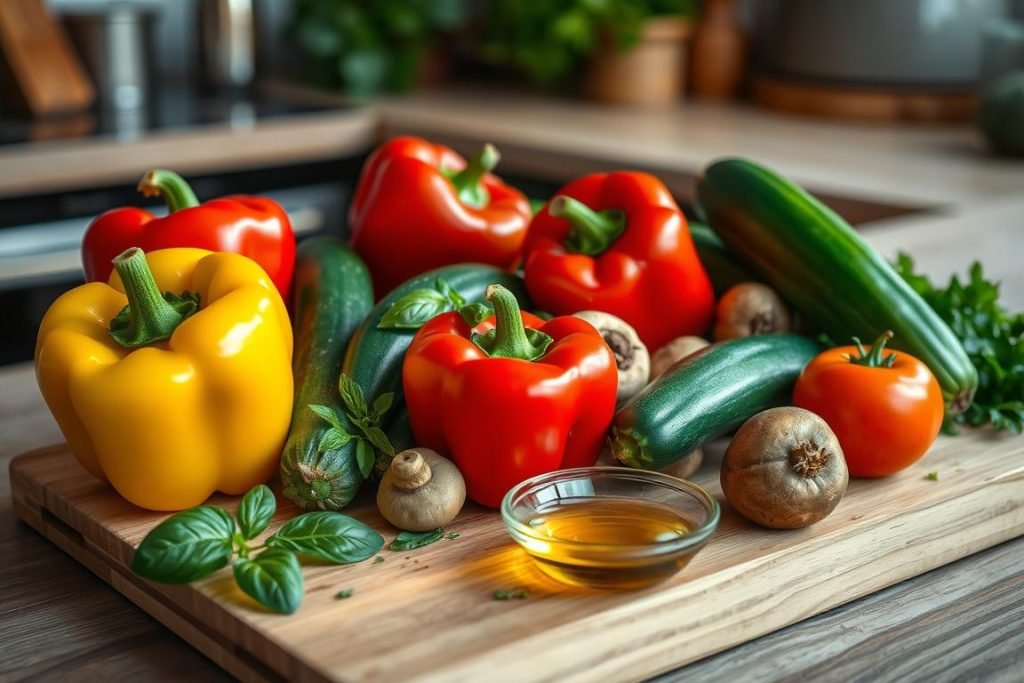
Preparing Ingredients for Sautéing
Before you start, how you prep your ingredients is key to sautéing success. The concept of mise en place, which means getting everything ready, is crucial. It ensures every part of your dish comes together well. This is very important for a cooking method as fast as sautéing.
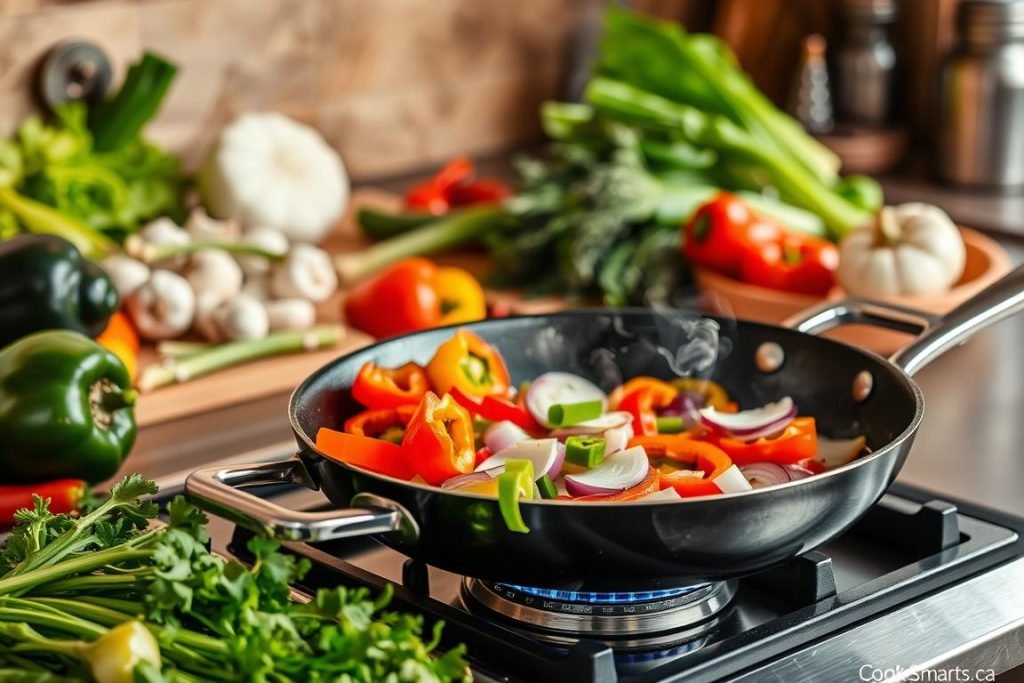
Properly Chopping Vegetables
When chopping vegetables, making sure they’re all the same size is important. This isn’t just for looks but also for them to cook evenly. It applies to any vegetable, like carrots, peppers, or onions. This way, they all cook at the same speed, avoiding any burnt or undercooked pieces. This careful chopping helps make your sautéed dishes excellent.
Marinating Meats
Since sautéing is quick, marinating your meats adds extra flavor. This works for chicken, beef, or seafood. A good marinade uses spices and oils that go well with high sautéing temperatures.
Portioning Ingredients
Cutting meats and proteins into even pieces is just as important as with vegetables. It makes sure everything cooks uniformly. After marinating, dry the meats off to avoid steaming in the pan. This is key for perfect sautéing.
Understanding mise en place improves your cooking, especially with sautéed dishes. Measuring, cutting, and portioning everything in advance makes cooking smoother. This preparation helps you excel at sautéing, turning basic ingredients into delicious meals easily.
The Ideal Cooking Oils for Sautéing
Picking the right oils is key to get better at sautéing, especially for high-heat dishes like stir-frying. If you know your oils, whether you cook at home or in a restaurant, you can really improve your skills.
Best Oils for High Heat
Oils that don’t break down at high temperatures are best for high-heat cooking. Avocado oil is great for this, as it has a very high smoke point. It’s perfect for both sautéing and stir-frying. Refined olive oil is another good option. It handles heat well and has a mild taste. Grapeseed oil is also a smart choice. It’s flexible and doesn’t overpower the flavors of your dish.
Flavor Profiles of Common Oils
Some oils are chosen for how they taste. Extra-virgin olive oil gives a fruity touch, great for Mediterranean food. Coconut oil has a hint of sweetness, fitting for certain Asian dishes. Butter adds depth with its rich flavor but burns fast. Use it at low heat or with another oil with a higher smoke point.
Oil Mixing Techniques
Mixing butter with an oil like canola or soybean boosts flavor and the smoke point. This trick is great for French and Italian sauté recipes that need butter’s taste and oil’s durability. When mixing oils, start with a neutral one. Then add oils like sesame or walnut for extra flavor.
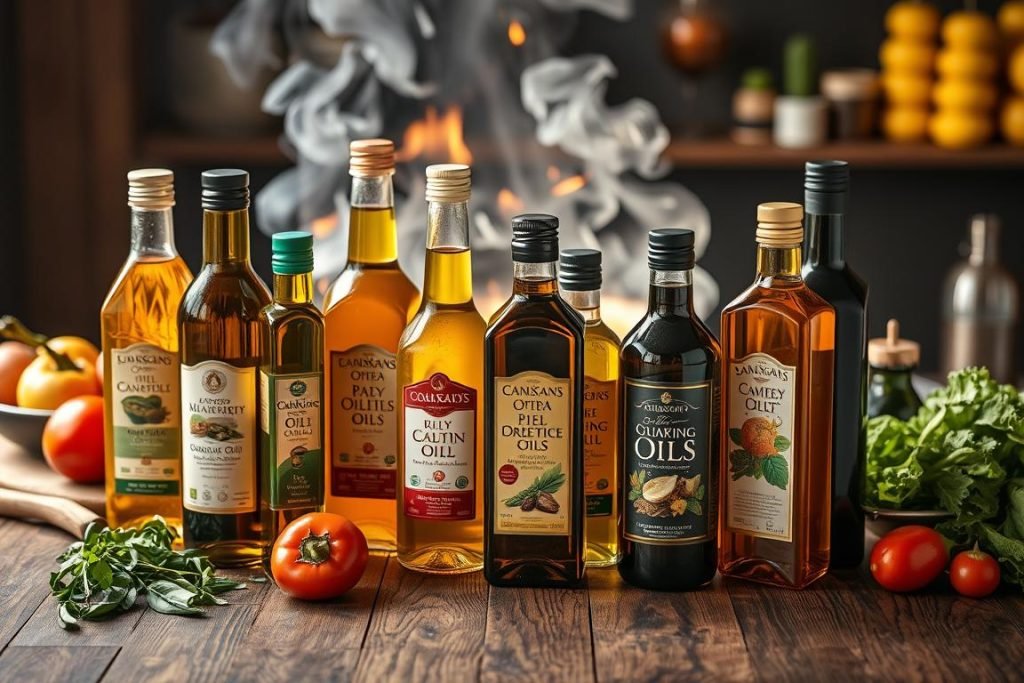
Choosing oils for sautéing? Think about the cooking technique and the dish’s flavors. For stir-frying and other high-heat methods, pick oils with high smoke points. This ensures even heat distribution without ruining the oil’s taste or health benefits.
Step-by-Step Guide to Sautéing
Sautéing is both an art and a science. It’s the perfect way to pan-fry food. You’ll cook quickly with a little bit of oil. Follow these steps to get dishes that are tasty and have great texture.
Preheating Your Pan
First, pick the right pan. A shallow, wide skillet works best. Heat it up on medium-high until it’s hot. Then, add just enough oil with a high smoke point for great sautéing.
Adding and Tossing Ingredients
Put your food in the pan in one layer. This lets it touch the heat directly. It’s key for a nice sear and avoiding mushy food. Keep things moving by tossing with a spatula or shaking the pan. This action helps everything cook well and get crispy outside.
Knowing When to Flip or Stir
Watch and listen for the sizzle and look for a golden color. It means it’s time to stir or flip. Doing this stops burning and cooks everything just right. The fond, or caramelized bits, add lots of flavor.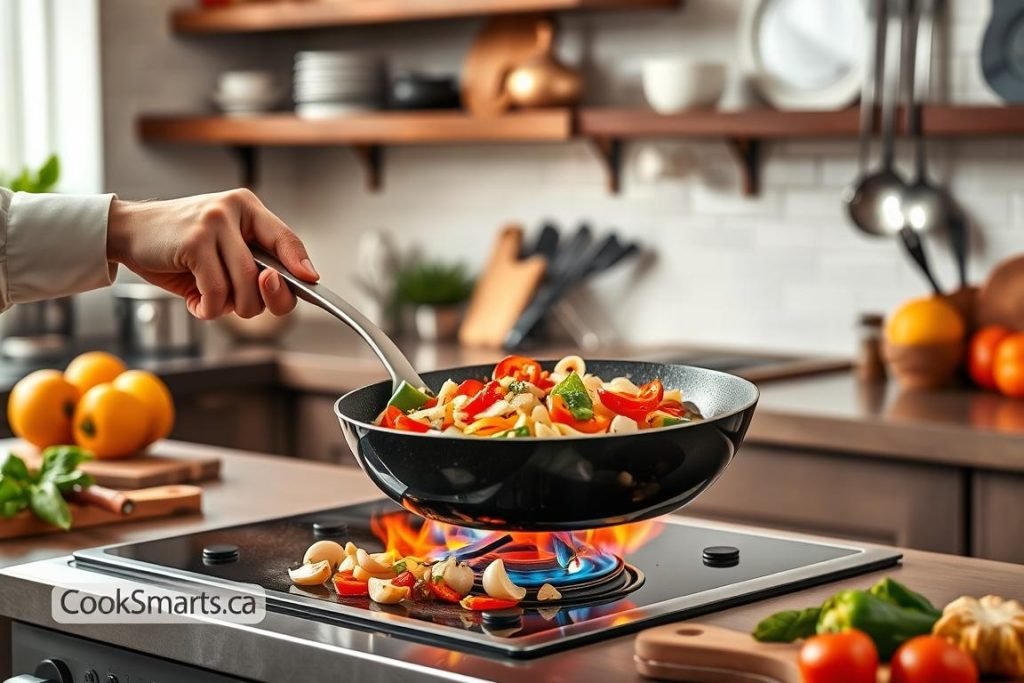
Table: Key Tips for Perfect Sautéing
| Tip | Description |
|---|---|
| Choice of Oil | Use oils with a high smoke point like avocado, canola, or coconut oil for optimal results. |
| Heat Level | Maintain a consistent medium-high heat to prevent under or overcooking. |
| Tossing Frequency | Toss frequently but not constantly; allow the food to sear and develop flavors. |
| Ingredient Preparation | Ensure ingredients are cut uniformly to promote even cooking. |
| Pan Choice | Select a pan that’s large enough to hold ingredients in a single layer. |
Stick to these tips and practice patience and precision. That way, you can improve your sautéing. You’ll make simple ingredients into amazing meals. They’ll be full of flavor and have the perfect texture.
Tips for Perfect Sautéing
Learning how to sauté well is key to cooking tasty meals. This skill is important for making great vegetable and meat dishes. Knowing how to cook with high heat will make your food better.
Avoiding Common Mistakes
Don’t put too much food in the pan. It might not brown properly. Make sure the pan is hot before you start. A water droplet should sizzle when it hits the pan. Use the right pan for the best heat.
Achieving the Right Texture
Controlling fat and heat is important for sautéing. Use oils that can handle high temperatures, like vegetable or canola oil. Clarified butter or ghee also works, but some people can’t eat dairy. Dry your food before cooking to get a good sear.
Using Color as an Indicator
Color tells you a lot when you’re cooking with heat. Look for a golden-brown crust. This means you’re doing it right. It makes your food taste and look good.
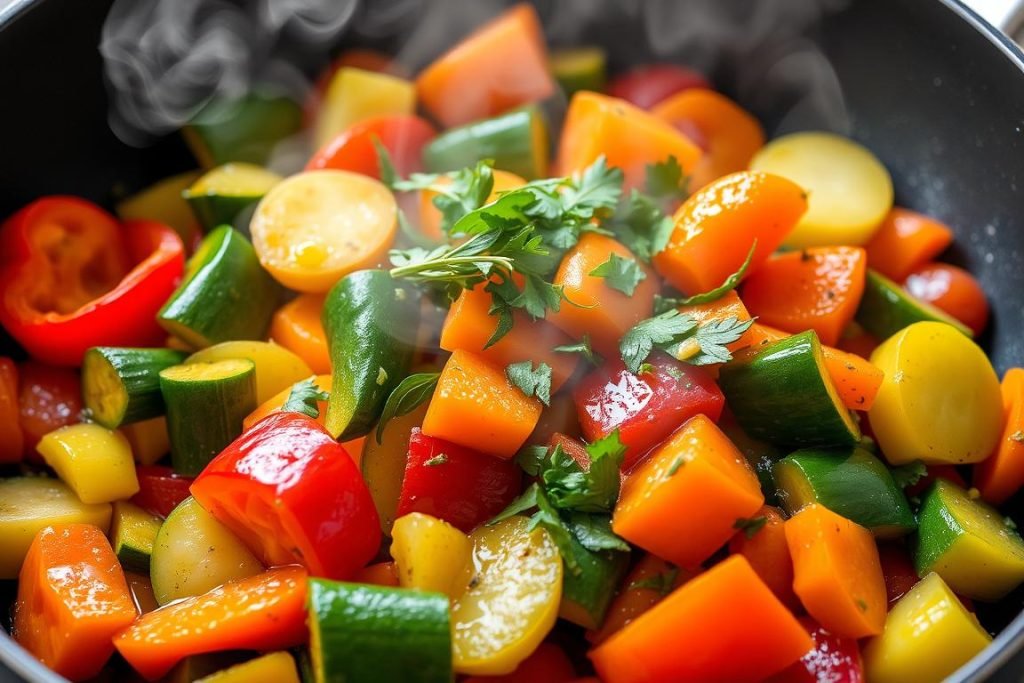
Flavor Enhancements While Sautéing
Making your sautéed dishes gourmet isn’t just about heating and tossing ingredients. Adding sauces, flavoring, and aromatic veggies lifts the taste. This turns simple sautés into amazing meals.
Adding Aromatics
Onions add crucial flavor foundations to dishes. Yellow onions, with their sweet taste, are perfect for caramelizing. They make your meals richer in taste.
Adding kosher salt boosts their flavor and helps bring out natural sugars. This makes the onions caramelize better. For more sweetness, a little sugar helps speed up caramelization, improving taste and texture.
Incorporating Sauces and Broths
Using sauces and broths deepens flavors. Try deglazing your pan with balsamic vinegar or wine. This trick uses the browned bits for flavor. Broths enhance moisture and give a smooth feeling.
A fresh stock, made from bones and veggies, adds great flavor. Adding it to your sauté makes it moist and adds silkiness.
Finishing Touches for Extra Depth
Adding specific enhancements changes the flavor. Olive oil or lemon juice before serving makes dishes vibrant. Toasted nuts give crunchiness and nuttiness.
Moderation is the secret. The aim is to enhance, not overwhelm, your main ingredients.
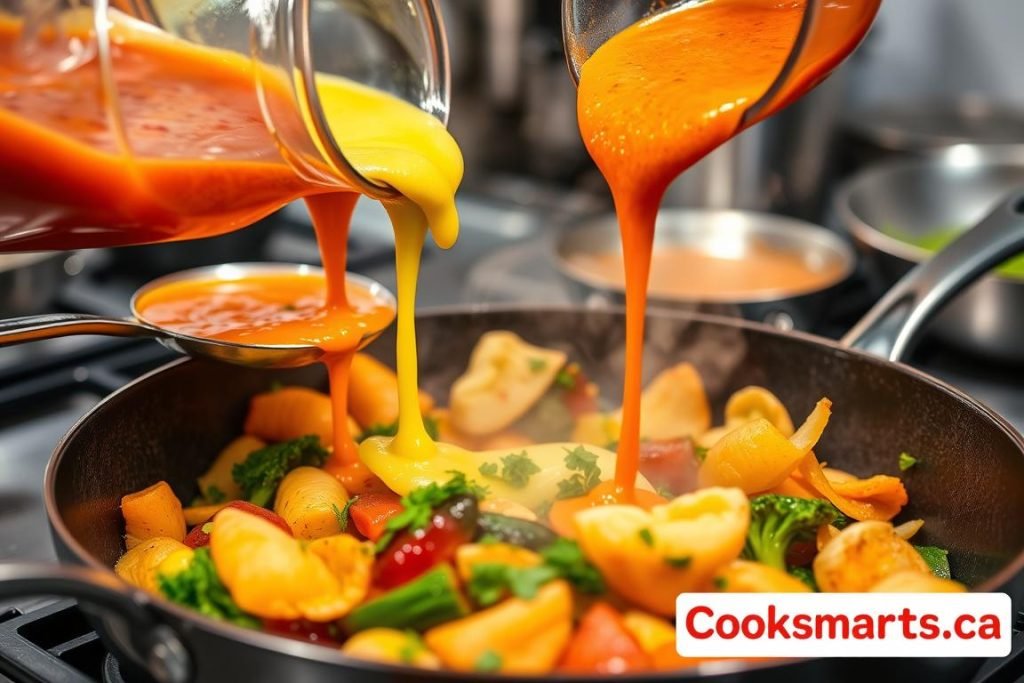
| Ingredient | Tip for Enhancement | Why It Works |
|---|---|---|
| Yellow Onions | Add to oil with a pinch of salt | Enhances sweetness through caramelization |
| Balsamic Vinegar | Splash during the final moments | Creates a robust, acidic glaze |
| Fresh Stock | Use as a deglazing liquid | Adds depth and a silky texture |
| High-quality Olive Oil | Drizzle before serving | Brings a fresh, rich flavor to dishes |
These techniques make sure every dish is perfectly cooked. And they are full of flavors and smells that show top-quality cooking.
Cleaning and Maintaining Your Cooking Tools
Learning to sauté well is the first step. Next, focus on cleaning and keeping your kitchen gear in top shape. This isn’t just a task; it’s an investment in your cooking tools’ longevity and the success of your skillet meals. A clean kitchen shows off your cooking skills. It also makes cooking safer and more efficient. Keeping up with maintenance can prevent accidents, lower stress, and save time. This all improves your sautéing skills.
Properly Cleaning Your Pan
Proper cleaning is crucial, regardless of your pan’s material. You should clean your cooking tools right after using them. This helps keep them in good shape. For example, stainless steel pans need gentle detergent and a good rinse. Cast iron pans need drying and seasoning to stop rust. Keeping your skillet in good condition ensures great results every time you cook.
Maintaining Utensils
Your kitchen utensils are as important as your hands when cooking. Train regularly and keep good maintenance records to keep them working well. Utensils also need preventive maintenance. This ensures they’re ready whenever you need them, whether for flipping veggies or stirring soups. Checking them for damage helps avoid problems while cooking. Sharp knives and sturdy spatulas make cooking safer and more precise.
Storing Ingredients Safely
Storing ingredients well is key to great sautéing. Keep your fridge and freezer clean and watch their temperatures. Plan for appliance repairs and maintenance to keep everything running well. This maintains your ingredients’ freshness for when you cook. A good storage system also keeps your kitchen safe and organized.